Disrupted Neural Pathways
More than 48 million people in the US, Europe and China suffer from neuromotor dysfunction resulting from stroke, amyotrophic lateral sclerosis, cerebral palsy, multiple sclerosis, Parkinson’s disease, traumatic brain injury, spinal cord injury and other neurological diseases. These neuromotor impairments can either be muscle weakness (paralysis and paresis), muscle tone disorders (spasticity, rigidity and low muscle tone) or muscle control problems resulting from damage to neural pathways. Genuine functional recovery remains elusive for these patients, and there are no pharmacological, surgical or physical interventions that can restore neuromotor function. In patients with these neurological conditions, disruption of the pathways leading from brain, through spinal cord, and to effector organs (e.g., muscle) results in impaired or deranged signal transmission.

Voluntary movement is initiated in the primary motor cortex of the brain, which is a well characterized region that maps directly to specific muscles in the body. From the primary motor cortex, signals descend through specific pathways in the brain, brainstem and spinal cord tracts and ultimately reach the muscle at the neuromuscular junction. Motor neurons are found in the spinal cord gray matter, and send axons directly to the muscles they innervate through peripheral nerves. Impairment or derangement of signal transmission can occur as a result of specific neurological disorders (stroke, ALS) or physical trauma (spinal cord injury), and can occur at the level of the brain, spinal cord or nerves that lead to specific muscles. Our proprietary Multi-Site DCS technology has been developed to non-invasively restore neural pathways damaged by these disorders.
